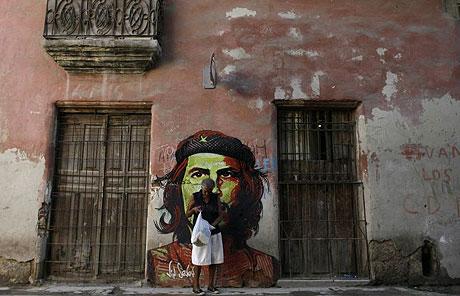Cuba: A Photograph as Metaphor
Cuba celebrated fifty years of its Communist Revolution the other day. It was a subdued celebration, as befits a celebration where the locals were not invited, and where the anniversary is marked by grief.
I was doing a roundup of posts for my blog's Monday Carnival of Latin America and the Caribbean when I came across this image:

The rusted wrought-iron balconies and fading handcrafted doors look back to an older era of artisanship and pride of ownership, now gone. Paint colors from decades ago, stucco coming apart from the wall, graffiti and mold, signal decay and pain.
Hope has bypassed that wall.
The photograph is in an article about Steven Soderbergh's latest movie, Che, but it is emblematic of today's Cuba: the only recent paint that building has seen is the iconic figure of Che (most prominently the Korda photo), whose myth and fiction override the reality of the hundreds of people he killed:
But a glance beneath the surface glamour of Alberto Korda's 1960 beret-and-curls photograph of Guevara is enough to expose the less-than-romantic reality. At the time he posed for Korda's camera, Guevara was jailer and executioner-in-chief of Castro's dictatorship. As boss of the notorious La Cabaña prison in Havana, he supervised the detention, interrogation, summary trials and executions of hundreds of "class enemies".The building it's painted on, like hundreds of other buildings in Cuba, won't be restored, or for that matter, brought back to minimum standards because it's not a tourist destination or owned by a Communist Party big-shot. Since in Cuba only the state has the right to sell property, and the average wage is $20 a month, the only way that building got new paint was a picture of Che. Like the Revolución, even that image is showing cracks.We know from Ernest Hemingway – then a Cuban resident – what Che was up to. Hemingway, who had looked kindly on leftist revolutions since the Spanish civil war, invited his friend George Plimpton, editor of the Paris Review, to witness the shooting of prisoners condemned by the tribunals under Guevara's control. They watched as the men were trucked in, unloaded, shot, and taken away. As a result, Plimpton later refused to publish Guevara's memoir, The Motorcycle Diaries.
There have been some 16,000 such executions since the Castro brothers, Guevara and their merry men swept into Havana in January 1959. About 100,000 Cubans who have fallen foul of the regime have been jailed. Two million others have succeeded in escaping Castro's socialist paradise, while an estimated 30,000 have died in the attempt.
The woman in front of the building looks at the contents of a small shopping bag, where she may be carrying the meager rations that Fidel Castro introduced in the country in 1962, rations that compare to that which Cuban slaves received in the 1840s.
A month's rations would fit in that bag.
Of course there's a propaganda aspect, and the Cuban government places the blame for nearly everything on the USA and the embargo, el bloqueo, even when the US is Cuba's #5 trading partner according to the Cuban government's own figures:
Trade data for 2007 posted on the website of Cuba's National Statistics Office placed the U.S. fifth at $582 million, compared with $484 million in 2006, including shipping costs.By the way, food and medicine were never subject to the embargo.
The huge painting of the Che image is on a wall that has been decaying for decades, as the Revolución that brought it.
Fausta Wertz also blogs at faustasblog.com.



